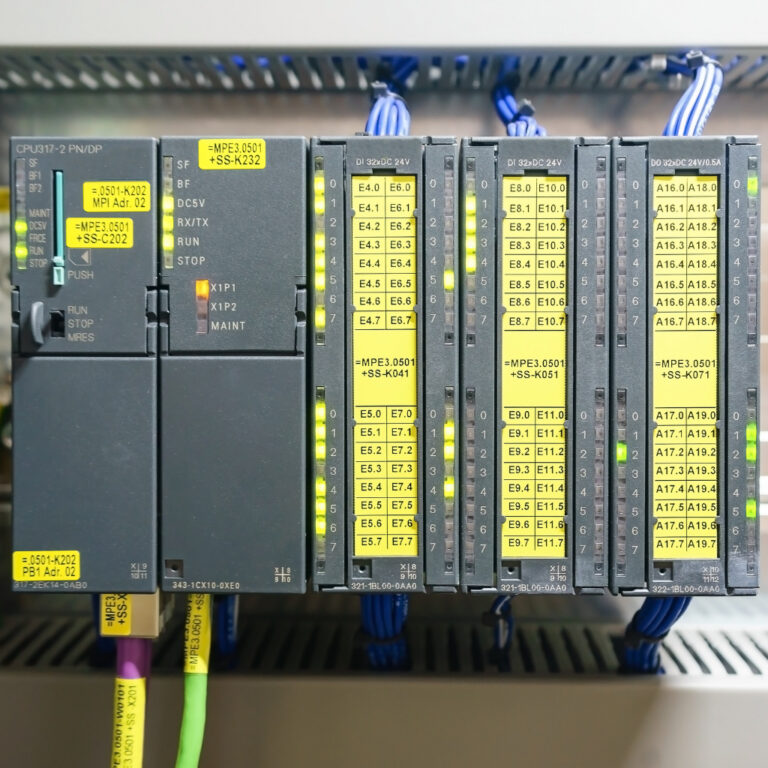- Reservedele
- Emergency Repair Service
- Repairer of electronics and automation products
- Omfattende testopstillinger
- ISO 9001 certified
If your PLC is broken, we can help you. We troubleshoot and repair PLCs daily, and have over 35 years of experience in the field.
You can either send your PLC to us or we can drive out to your company and repair it.
We also have programming software for several brands of PLCs, so we can access your PLC. In that way, we can see the status of inputs, outputs and the program.
Contact us today - help is on its way!

We have a large selection of PLCs from many brands: Allen-Bradley, Siemens, Schneider Electric, Bosch, Schleicher, Omron, IDEC and many more.
We can supply the latest models on the market, but we are also specialists in obtaining discontinued PLCs for older machines. We can deliver most things.
Contact us and find out more.
Find answers to questions regarding the purchase and repair of PLCs.
At PRO-CONSULT, we offer a wide selection of PLCs from leading brands such as Siemens, Allen-Bradley, Mitsubishi, Omron, and many more. Contact us to hear about specific models and manufacturers.
We repair most types of PLCs from many different manufacturers. Our technician team has extensive experience with both newer and older models.
Yes, we offer onsite service, where one of our technicians comes out to your business to carry out repairs, installations or troubleshooting directly on site. However, it can often be better to hand in or send your PLC to us.
Yes, we often sell used PLCs. It can be a great advantage for you who have an older plant or machine where the parts have been discontinued. Contact us and tell us which part you are looking for and we will get it for you.
A PLC is now used in many industries.
PLCs are widely used in manufacturing to control machines and production lines. They ensure precise control of machinery, ensuring uniformity and efficiency in production.
In e.g. both the car industry and in the production of electronics, PLCs are indispensable in relation to maintaining high production speeds and quality.
In the food industry, PLCs are essential for automating processes such as mixing, packaging, and filling. They help maintain hygiene requirements and product quality by ensuring precise and controlled environments.
PLCs are used to monitor and control complex processes such as drilling, refining and distributing oil and gas.
PLCs are also integrated into building management systems, where they control everything from heating and ventilation to security systems. They make it possible to manage complex building systems efficiently and increase energy efficiency
PLCs are also integrated into building management systems, where they control everything from heating and ventilation to security systems. They make it possible to manage complex building systems efficiently and increase energy efficiency.
In the water and wastewater treatment industry, PLCs are used to control pumps, filters and other systems that ensure water treatment is done efficiently and in accordance with environmental standards.
Here, PLCs are a key component in automated production lines that produce cars and their components. They ensure precision and uniformity in production, which is paramount in the automotive industry.
PLC stands for Programmable Logic Controller and is a computer unit that was invented in 1968. It is a control unit for machines and plants, and in short consists of inputs and outputs. It receives signals through inputs and then activates outputs based on which inputs it has received.
In 1968, the car manufacturer General Motors wanted a new control unit for cars. Therefore, General Motors made a tender with the requirements they had for the control unit. Bedford Associates therefore invented the PLC, which met the needs of a control unit at General Motors.
Today there is a large selection of PLCs in different looks and sizes from different manufacturers, e.g Allen-Bradley and Schneider, and the component is used in virtually all large plants and machines.
Keep up to date with the latest news and services from PRO-CONSULT.

We are local experts in industrial electronics. Through our departments in Viby Sjælland, Vejle and Padborg, we cover Denmark and other countries.